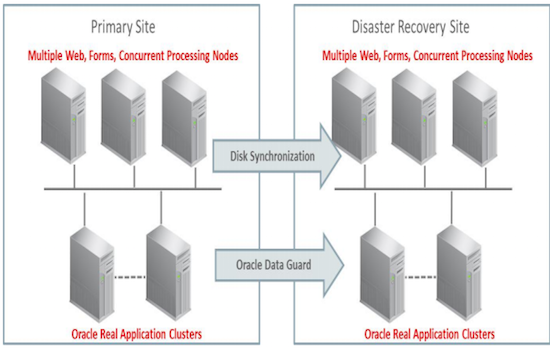Whether Oracle E-Business Suite is deployed in the Cloud or on-premises, planning for and implementing strategies for high availability and disaster recovery are paramount. A new white paper is available that applies the principles of Oracle’s Maximum Availability Architecture (MAA) to the Oracle E-Business Suite 12.2 infrastructure:
The major difference between the methods described here for Oracle E-Business Suite Release 12.2 and those documented elsewhere for earlier EBS releases is the use of logical host names instead of physical host names in the EBS managed topology. This allows us to make the configuration of the standby site the same as the primary site, from an Oracle E-Business Suite perspective, thus allowing you to switch between the two sites with minimal configuration efforts and facilitating a reduction in downtime as compared to using physical host names.

This whitepaper covers:
- Overview of Oracle’s engineered systems: Exadata and Exalogic
- Technology components in Oracle Database MAA, including:
- Real Application Clusters and Oracle Clusterware
- Oracle Data Guard
- Oracle Flashback Database
- Oracle Automatic Storage Management
- Oracle Recovery Manager and Oracle Secure Backup
- EBS technology components in MAA, including:
- Parallel Concurrent Processing (PCP)
- Multiple load-balanced application tier services
- Online Patching and Edition-based Redefinition
- Logical host names
- Fusion Middleware Administration Server
- EBS Configuration best practices
- OS Role separation
- Database initialization parameters
- Linux HugePages
- Backups of Database Oracle Homes
- Database password expiration
- Exadata Fast Node Death Detection
- Timeouts for RAC Node Failures
- Flashback Database implementation
- Exadata Smart Flash Logging
- Exadata Smart Flash Cache
- Exadata memory management
- Oracle Advanced Compression
- Exadata Log Writer tuning
- Fixed object statistics
- Exadata I/O Resource Manager
- Oracle Engineered Systems best practices and health check
- And much more!
This white paper is mandatory reading for EBS architects and system administrators designing a business continuity or disaster recovery strategy and architecture.
Related Articles
